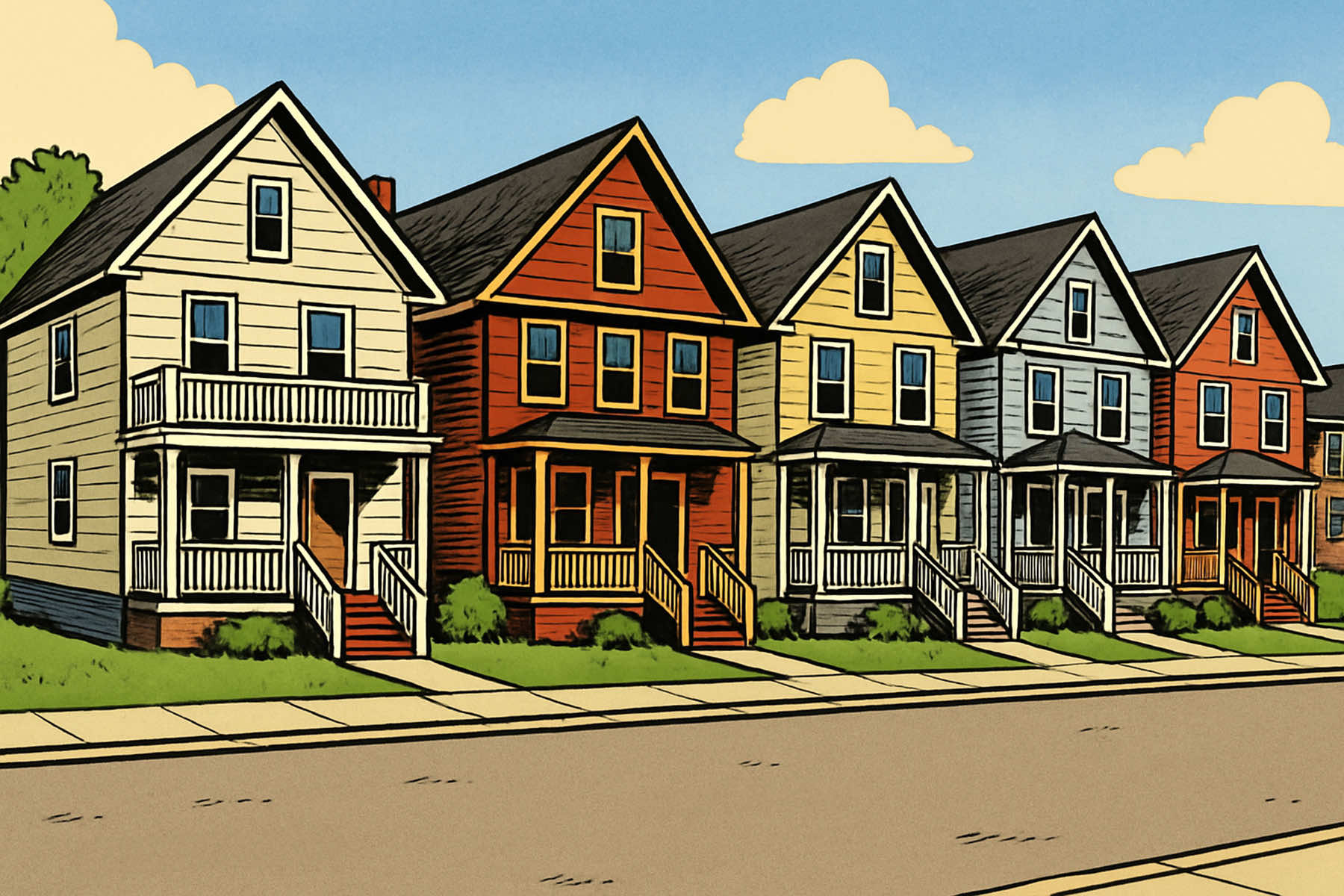
In neighborhoods already grappling with housing insecurity, a deeper pattern is emerging beneath Milwaukee’s high eviction rates: clusters of properties in eviction hotspots are owned by a small number of landlords, many of whom repeatedly appear in court records, delinquent tax rolls, and housing violation reports.
While public attention has largely focused on eviction statistics, especially in the wake of the pandemic and subsequent rent spikes, less scrutiny has been applied to the owners profiting from the churn.
A review of records from the Wisconsin Circuit Court Access system (CCAP), Milwaukee’s Assessor’s Office, and eviction tracking projects shows that in certain ZIP codes, evictions are not isolated acts of hardship but part of a high-volume business model.
In the 53206, 53209, and 53210 ZIP codes, neighborhoods with some of the city’s highest eviction filings, court records indicate that a handful of landlord entities are responsible for filing hundreds of eviction cases annually.
Many of these companies are registered under shell corporations or real estate trusts, making them difficult to identify by name. Cross-referencing CCAP case numbers with assessor records and LLC registries reveals that these ownership webs often trace back to the same limited pool of individuals or property firms operating across dozens of units.
One such entity, which appeared in more than 150 eviction cases over a two-year span, holds properties under at least six different LLCs. Despite this fragmentation, the legal filings show recurring addresses, court appearances, and even repeat allegations of building code violations and improper notice procedures.
The strategy, housing advocates say, is not merely reactive property management but a volume-driven practice that relies on a steady stream of tenant turnover. By cycling renters through short-term, high-rent leases in distressed properties, these landlords can extract maximum returns with minimal investment, especially in areas where enforcement is lax and affordable alternatives are scarce.
Public records indicate that many of the properties in question are also tax delinquent. According to Milwaukee’s property tax portal, several of the landlords appearing frequently in eviction court have multiple properties in arrears. Some have gone unpaid for years.
In theory, these violations should prompt city intervention, but in practice, foreclosure actions are slow-moving, and housing code enforcement is inconsistently applied, particularly in lower-income districts.
Milwaukee’s landlord registry and building inspection records show patterns of repeated citations for the same properties. Yet the same buildings often remain in operation without substantive repairs.
In several cases, properties filed for eviction multiple times in a single year also had open violations related to lack of heat, rodent infestations, or dangerous structural issues. Without systemic intervention, landlords can continue to operate without consequence.
While eviction filings are a matter of public record, the full picture of landlord activity emerges only when multiple datasets are combined. The Milwaukee Eviction Tracker, developed by the Legal Aid Society of Milwaukee, provides granular data on where and how often evictions occur.
But when paired with ownership and tax records, it becomes clear that eviction hotspots are not simply the result of economic conditions — they are manufactured and maintained by property owners making deliberate decisions.
In some North Side neighborhoods, eviction records show that a majority of filings are concentrated among a small group of landlords. Each used multiple corporate entities and frequently moved properties among LLCs.
This not only complicates accountability but also makes enforcement by city agencies more difficult. Repeated code violations are often recorded against a now-defunct LLC, while the physical property continues to be rented under a new corporate name.
Tax records and assessor data also reveal another pattern: these landlords often purchase distressed properties at low cost, usually through sheriff’s sales or bulk acquisitions, and make minimal improvements before renting at above-market rates for the area.
Tenants, many of whom are low-income or receiving housing assistance, are lured in by the promise of quick move-ins and flexible terms, only to face eviction within months for nonpayment or complaints about conditions.
This cycle disproportionately affects Black and Latino renters, who make up the majority of tenants in Milwaukee’s most heavily affected districts. Though Milwaukee is one of the most racially segregated cities in the United States, the ownership of rental housing is increasingly concentrated among absentee landlords based in wealthier suburban communities or out of state.
In contrast to smaller, local landlords — many of whom reside in or near the properties they manage — these high-volume operators are often insulated from tenant concerns. Communications are routed through property management firms or third-party services.
Court filings are often automated, filed in batches with minimal review. The result is a legal assembly line, in which eviction becomes a primary management tool rather than a last resort.
This approach is not technically illegal, but it raises serious ethical and policy questions. City officials and housing advocates have acknowledged the imbalance, but enforcement tools remain limited. The Milwaukee Department of Neighborhood Services, responsible for housing code compliance, faces staffing shortages and a backlog of inspections.
Meanwhile, eviction court moves swiftly, often processing dozens of cases in a single morning session, most without legal representation for the tenant. Legal Aid attorneys note that tenants in these buildings frequently face barriers in contesting evictions, even when violations are present.
A lack of documentation, language barriers, or previous negative experiences with the system can dissuade renters from pushing back. In some cases, tenants leave before the court date, having already received multiple notices or informal threats of lockout.
The economic incentives for this model are clear. Data from Community Advocates, a Milwaukee-based housing nonprofit, shows that eviction filings spike seasonally, particularly before winter and again in spring, aligning with utility shutoff moratoriums and school year transitions.
For predatory landlords, this allows them to fill vacancies, raise rents, or reset lease terms to extract higher margins. The long-term impacts, however, are devastating. Frequent evictions create instability that ripples through entire neighborhoods.
Children are pulled from schools, tenants lose possessions left behind in hurried moves, and families are forced into substandard or temporary housing. The stigma of eviction also makes future rental applications more difficult, even when the tenant was not at fault.
Beyond the direct impact on renters, this pattern erodes neighborhood cohesion. Properties with high turnover are less likely to be maintained, contributing to blight and declining property values. Neighboring homeowners and small landlords suffer as well, with the externalities of neglect dragging down surrounding blocks.
Vacant homes become targets for theft, fires, or illegal dumping, placing additional burdens on city services. Efforts to rein in predatory landlord behavior have had limited success.
Milwaukee has no formal rent control, and state-level preemption laws limit municipal authority to impose stronger tenant protections. Attempts to create a “bad actor” landlord list or bar serial violators from acquiring new properties have been stymied by legal challenges and loopholes.
Still, housing advocates continue to push for reform. Some have called for stronger data integration between departments, mandatory landlord training, and more proactive inspections triggered by patterns of repeated filings or code violations. Others argue for expanding tenant right-to-counsel programs, which have shown promise in reducing evictions in cities like New York and San Francisco.
Public pressure is also beginning to mount. As more data becomes available through open records requests and third-party analysis, a clearer picture is emerging of how concentrated landlord ownership intersects with Milwaukee’s eviction crisis.
Journalists, legal organizations, and housing researchers are beginning to map these networks in greater detail, shedding light on ownership structures previously hidden behind bureaucratic opacity.
The challenge, however, remains one of political will. Many of the landlords operating in these eviction hotspots are well-resourced and legally savvy. Some are campaign donors, others hold influence through real estate lobbying groups. Addressing the problem will require not just better data, but structural changes that prioritize housing stability over speculative profit.
For now, tenants in Milwaukee’s hardest-hit neighborhoods remain locked in an unequal struggle, where eviction is not merely a consequence of poverty, but a tactic of profit extraction. As long as landlords can exploit the gaps between ownership, accountability, and enforcement, the cycle will persist.
© Art
Isaac Trevik














